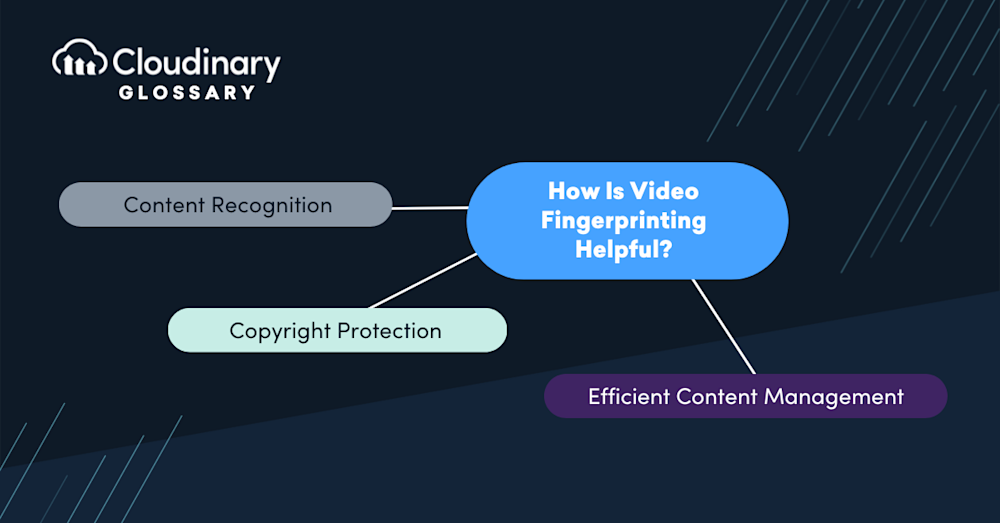What Is Video Fingerprinting?
Video Fingerprinting is a content identification technology that generates a unique digital signature, or “fingerprint,” for a specific video file. This fingerprint is created by analyzing various visual and auditory features within the video, such as color distribution, motion characteristics, audio patterns, and more. Once a video is fingerprinted, this signature is a unique identifier that can be compared against a database of known fingerprints for content matching and recognition.
Video Fingerprinting vs. Watermarks
Video fingerprinting and digital watermarks are both techniques used to protect and identify multimedia content, but they function in markedly different ways. Video fingerprinting essentially creates a unique identifier for a video, akin to a digital “fingerprint,” by analyzing various attributes such as frame composition, color distribution, and audio patterns. This process does not alter the content itself but instead generates a separate and distinct signature that can detect copies or variations of the video across platforms.
On the other hand, digital watermarks are invisible or barely perceptible markers embedded directly into the video material. These marks can carry a variety of information, including copyright notices, creator identification, or usage rights, persisting within the media even if it undergoes transformations like compression or format conversion.
The choice between video fingerprinting and watermarking hinges on the specific requirements and challenges content creators and distributors face. Watermarking offers a robust method to claim ownership and trace unauthorized distribution; however, it requires access to the original file for embedding information, and sophisticated techniques might be necessary to conceal the watermark effectively. Video fingerprinting, conversely, shines in scenarios demanding content identification and monitoring across diverse platforms without tampering with the original content. It enables content owners to scan for matches or infringements efficiently, facilitating a proactive content protection approach.
How Is Video Fingerprinting Helpful?
Video Fingerprinting offers several key benefits that enhance content identification and protection:
- Content Recognition – By creating a unique fingerprint for each video, content creators and platforms can accurately identify their own content across various online channels and detect unauthorized use or piracy.
- Copyright Protection – Video Fingerprinting technology plays a vital role in safeguarding intellectual property rights by enabling creators to monitor the distribution and use of their content, detect copyright infringement, and take appropriate action to protect their work.
- Efficient Content Management – Video Fingerprinting simplifies the process of organizing and managing large libraries of video content by automating the identification and categorization of videos based on their unique fingerprints.
Where is Video Fingerprinting Used?
Video Fingerprinting technology is utilized in various industries and applications to enhance content identification, copyright protection, and content management processes:
- Content Distribution Platforms – Video streaming services and content distribution platforms leverage Video Fingerprinting to ensure that only authorized content is shared and to detect and mitigate piracy and unauthorized distribution.
- Digital Rights Management (DRM) – DRM solutions use Video Fingerprinting to protect copyrighted content, enforce licensing agreements, and prevent unauthorized use and distribution of videos across digital platforms.
- Broadcast Monitoring – Broadcasters and media companies use Video Fingerprinting to monitor live broadcasts, track the usage of commercials, and analyze audience engagement with televised content.
- Anti-Piracy Efforts Content owners and rights holders employ Video Fingerprinting technology as part of their anti-piracy strategies to detect and combat illegal sharing, streaming, and distribution of copyrighted videos online.
Final Thoughts
Video Fingerprinting technology plays a critical role in content identification, copyright protection, and digital asset management in the ever-evolving landscape of digital media. By generating unique fingerprints for videos and comparing them against databases of known content, Video Fingerprinting allows content creators, distributors, and rights holders to safeguard their intellectual property, combat piracy, and enforce licensing agreements effectively.
As the demand for video content continues to grow, the importance of Video Fingerprinting as a key tool in content recognition and copyright protection cannot be understated. By implementing Video Fingerprinting technology, organizations and platforms can ensure the integrity and security of their video assets. This technology is especially vital for protecting original videos, enabling creators to maintain control over their work while providing a safer and more reliable viewing experience for audiences worldwide.
Additional Resources You May Find Useful:





